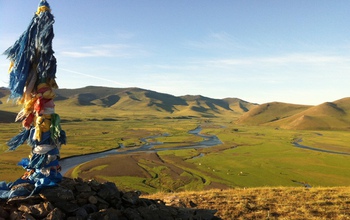Climate of Genghis Khan's ancient time extends long shadow over Asia of today

View of the modern-day Orkhon Valley near Karakorum, the ancient Mongol capital. Credit: Amy Hessl
Climate was very much on Genghis Khan's side as he expanded his Mongol Empire across northeastern Asia.
That link between Mongolia's climate and its human history echoes down the centuries, according to findings reported in this week's issue of the journal Proceedings of the National Academy of Sciences (PNAS).
But climate may no longer be the boon it was during the latter, wetter part of Genghis Khan's reign. The early years were marked by drought.
Mongolia's current drought conditions could have serious consequences for the Asia region's human and other inhabitants.
The discovery linking ancient and modern history hinges on wood. Trees provide an extensive climate record in their rings.
The tree rings' tales of ebbs and flows in water availability show that Genghis Khan took power during a severe drought, says Amy Hessl, a geographer at West Virginia University and co-author of the paper.
But, the scientists found, the rapid expansion of Genghis Khan's empire coincided with the wettest period in the region during the last millennium.
“Through a careful analysis of tree-ring records spanning eleven centuries, the researchers have provided valuable information about a period of great significance,” says Tom Baerwald, a program director for the National Science Foundation's (NSF) Dynamics of Coupled Natural and Human Systems (CNH) Program, which funded the research.
CNH is one of NSF's Science, Engineering and Education for Sustainability (SEES) programs. CNH is supported by NSF's Directorates for Geosciences; Biological Sciences; and Social, Behavioral & Economic Sciences.
“The results also provide insights into the complex interactions of climate, vegetation and human activity in semi-arid regions today,” Baerwald says.
Though political realities would also have played into Genghis Khan's power grab, the regional climate at the time appears to have supported his empire's expansion.
The climate provided literal horsepower as armies and their horses fed off the fertile, rain-fed land.
“Such a strong and unified center would have required a concentration of resources that only higher productivity could have sustained, in a land in which extensive pastoral production does not normally provide surplus resources,” the paper states.
While the ramifications for past history are significant, so, too, are they for today's.
The scientists believe that human-caused warming may have exacerbated the current drought in central Mongolia, similar to the drought that coincided with Genghis Khan's initial rise to power.
“If future warming overwhelms increased precipitation, episodic 'heat droughts' and their social, economic and political consequences will likely become more common in Mongolia and Inner Asia,” according to the paper.
Hessl co-authored the report with scientists Neil Pederson of the Lamont-Doherty Earth Observatory, Nachin Baatarbileg of the National University of Mongolia, Kevin Anchukaitis of the Woods Hole Oceanographic Institution and Nicola Di Cosmo of the Institute for Advanced Study.
-NSF-
Media Contacts
Cheryl Dybas, NSF, (703) 292-7734, cdybas@nsf.gov
Diana Mazzella, WVU, (304) 293-6998, diana.mazzella@mail.wvu.edu
Related Websites
Science, Engineering and Education for Sustainability NSF-Wide Investment (SEES): http://www.nsf.gov/funding/pgm_summ.jsp?pims_id=504707
NSF Publication: Discoveries in Sustainability: http://www.nsf.gov/pubs/2012/disco12001/disco12001.pdf
NSF News: National Science Foundation awards $19.4 million for research on coupled natural and human systems: http://www.nsf.gov/news/news_summ.jsp?cntn_id=129178&org=NSF&from=news
NSF Discovery Article: Summertime: Hot Time in the City: http://www.nsf.gov/discoveries/disc_summ.jsp?cntn_id=128204
NSF Discovery Article: Cooking Up Clean Air in Africa: http://www.nsf.gov/discoveries/disc_summ.jsp?cntn_id=126403&org=NSF&from=news
NSF Discovery Article: Soundscapes: Studying Nature's Rhythms: http://www.nsf.gov/discoveries/disc_summ.jsp?cntn_id=126403&org=NSF&from=news
The National Science Foundation (NSF) is an independent federal agency that supports fundamental research and education across all fields of science and engineering. In fiscal year (FY) 2014, its budget is $7.2 billion. NSF funds reach all 50 states through grants to nearly 2,000 colleges, universities and other institutions. Each year, NSF receives about 50,000 competitive requests for funding, and makes about 11,500 new funding awards. NSF also awards about $593 million in professional and service contracts yearly.
Media Contact
All latest news from the category: Earth Sciences
Earth Sciences (also referred to as Geosciences), which deals with basic issues surrounding our planet, plays a vital role in the area of energy and raw materials supply.
Earth Sciences comprises subjects such as geology, geography, geological informatics, paleontology, mineralogy, petrography, crystallography, geophysics, geodesy, glaciology, cartography, photogrammetry, meteorology and seismology, early-warning systems, earthquake research and polar research.
Newest articles

Properties of new materials for microchips
… can now be measured well. Reseachers of Delft University of Technology demonstrated measuring performance properties of ultrathin silicon membranes. Making ever smaller and more powerful chips requires new ultrathin…

Floating solar’s potential
… to support sustainable development by addressing climate, water, and energy goals holistically. A new study published this week in Nature Energy raises the potential for floating solar photovoltaics (FPV)…

Skyrmions move at record speeds
… a step towards the computing of the future. An international research team led by scientists from the CNRS1 has discovered that the magnetic nanobubbles2 known as skyrmions can be…




















